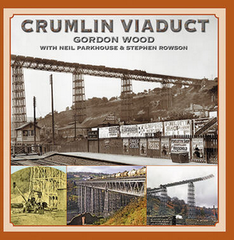Crumlin Viaduct
This is the story of a brilliant but flawed engineer, who built a brilliant but flawed bridge.
Thomas W. Kennard is both the hero and villain of this book, a man who, in 1852 – just over two decades after the Rainhill Trials – accepted a verbal contract from the Newport, Abergavenny & Hereford Railway Company to build an enormous viaduct 1,500 feet long and rising up to 200 feet above the Ebbw Valley. Constructed almost entirely of iron and completed in 1857, the finished viaduct was a thing of grace and beauty, and the pride of the Ebbw and Kendon valleys which it spanned.
Kennard, however, had proved obstructive and uncommunicative during the construction, constantly running short of money and pressurising the company for extra payments. Deliveries were late, record and stock keeping was poor and the lack of a written contract – one was only drawn up after the viaduct had been built – all led to the inevitable ‘day in court’. Within twenty years of its completion, repairs were becoming necessary and from the early years of the 20th century, the Great Western Railway began considering its total reconstruction or even a deviation of the line which it carried. British Railways realised in the late 1950s that the viaduct had a very limited life span without serious remedial work or rebuilding, whilst the structure had been listed in 1961 which served to further complicate matters.
In the end, the 1963 Beeching Report did for the Vale of Neath line, which closed in June 1964 and sealed Crumlin Viaduct’s fate. Demolition of the structure was completed in spring 1966 but not before a last brief burst of fame when it starred in the Hollywood movie Arabesque, alongside Gregory Peck and the beautiful Italian actress Sophia Loren. Within these pages, the authors tell the story of the viaduct from start to finish, with comprehensive details of its design and construction, and of the later repairs, of Kennard’s case in the Court of Arbitration, of the traffic that passed over it and finally how this huge structure was demolished. They also look at other related aspects, such as the early tramroads which passed beneath it, the Llanhilleth Branch from Crumlin Junction, and at Crumlin Navigation Colliery.
The viaduct was one of the very first railway subjects to be photographed, from the start of building, by the London Stereoscopic Company, of which Kennard’s brother Henry was a director. Lavishly illustrated, with a plethora of photographs from construction in the 1850s to demolition in the mid-1960s, along with maps and a huge range of drawings and plans, this book will therefore stand as a fitting memorial to one of the most iconic bridges ever built and one still much missed in the Welsh valleys it graced for 110 years.
324 large square format pages. Hardbound. A beautiful book, and a very interesting story ...










